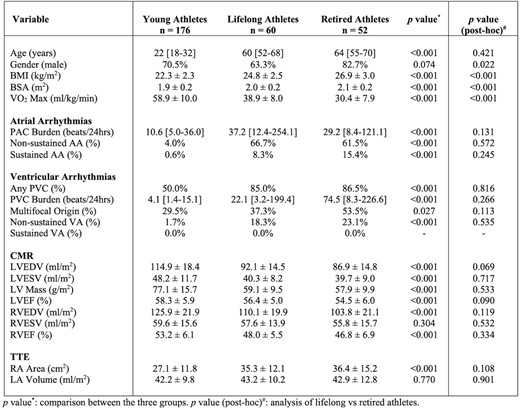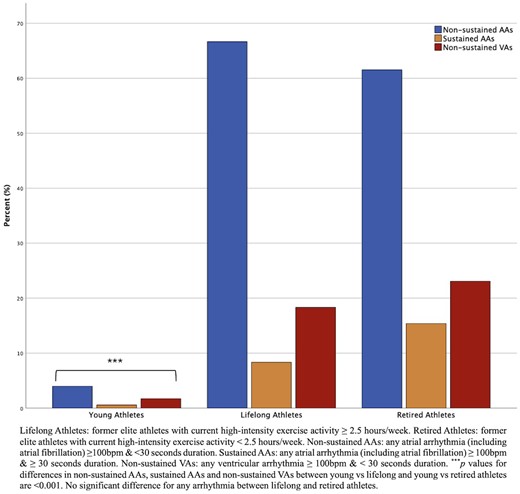-
PDF
- Split View
-
Views
-
Cite
Cite
P D'ambrosio, K Janssens, A Mitchell, S Rowe, G Claessen, R Willems, H Heidbuchel, P Kistler, J Kalman, A La Gerche, Pro@Heart Consortium , Atrial and ventricular arrhythmias in young, lifelong and retired elite endurance athletes, European Heart Journal, Volume 45, Issue Supplement_1, October 2024, ehae666.436, https://doi.org/10.1093/eurheartj/ehae666.436
Close - Share Icon Share
Abstract
Whilst endurance athletes are known to have an overall higher prevalence of atrial fibrillation (AF), the prevalence of other non-sustained and sustained atrial arrhythmias (AAs) and ventricular arrhythmias (VAs) remains poorly defined.
We aimed to define the prevalence of non-sustained and sustained AAs (including AF) and VAs in a healthy cohort of young, lifelong and retired elite endurance athletes. We also sought to assess associations between arrhythmias, fitness and measures of cardiac structure.
Holter monitors in healthy endurance athletes (n=288) from an international cohort of elite endurance athletes (the Pro@Heart consortium) were analysed for the presence of sustained and non-sustained AAs and VAs. Athletes were sub-divided into young elite athletes (n=176) and former elite athletes (n=112) of which 60 were lifelong (≥2.5 hours/week) and 52 retired (<2.5 hours/week) athletes (determined by current high-intensity exercise activity). Each athlete underwent cardio-pulmonary exercise testing, echocardiography and contrast-enhanced cardiac MRI. Participants with known structural or electrical cardiac disease were excluded. Independent T-test / One-Way ANOVA (parametric data) or Mann-Whitney U / Kruskal-Wallis Tests (non-parametric data) assessed for differences between the groups.
Young athletes (n=176, 70.5% male) were significantly fitter with a greater degree of cardiac remodelling as compared with lifelong (n=60, 63.3% male) and retired (n=52, 82.7% male) athletes (Figure 1). The prevalence of non-sustained AAs (young: 4.0% vs lifelong: 66.7% vs retired: 61.5%, p<0.001), sustained AAs (young: 0.6% vs lifelong: 8.3% vs retired: 15.4%, p<0.001) and non-sustained VAs (young: 1.7% vs lifelong: 18.3% vs retired: 23.1%, p<0.001) was higher in lifelong and retired athletes compared with young athletes (Figure 2). Non-sustained VAs were predominately monomorphic (85%), short and moderate rate (median duration 2.8 seconds and heart rate 154 beats per minute). No athletes developed sustained VAs and/or sudden cardiac arrest. Young athletes had less VAs that were multifocal in origin compared with lifelong and retired athletes (young: 29.5%, lifelong: 37.3%, retired: 53.5%, p=0.027). There was no difference in prevalence of any arrhythmia between lifelong and retired athletes. There were no significant correlations between arrhythmias and fitness or cardiac imaging parameters.

Arrhythmias and cardiac imaging

Arrhythmias amongst athlete groups
Author notes
Funding Acknowledgements: Type of funding sources: Private grant(s) and/or Sponsorship. Main funding source(s): Royal Australian College of Physicians
National Health and Medical Research Council / Heart Foundation



